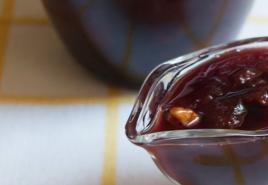Water saving nozzle to save water. Instructions for saving water, best methods. Types of faucet attachments
Is a faucet attachment really necessary to save water? Or is this just another hyped trinket? And will it help you save money personally?
More recently, we looked at the “energy saver” and found out that it has very little to do with true savings. It seems that it is precisely because of such devices that people have become wary of even truly useful inventions.
These included water-saving faucet attachments, the reviews of which are very controversial. Or maybe it’s all the fault of unfortunate PR people who either themselves do not understand the principle of operation of the aerator or attribute to it absolutely fabulous properties. Meanwhile, the logic of the device’s operation is very simple and easy to explain.
Water saving spray nozzles
If anyone remembers, back in Soviet time faucet devices were sold that reduced the diameter of the spout. This was probably the first faucet attachment I saw for .
This principle is familiar to anyone who has ever held a water hose in their hands. We cover thumb hole - we get a thin stream with good pressure. We release the finger - the pressure decreases, the throughput increases. The simplest water-saving faucet attachments, called “sprays,” work in exactly the same way. They increase the pressure by reducing the throughput, breaking the water into small streams.
A couple of years ago I bought myself a “gadget” called an “LED faucet attachment with water illumination.”
To be honest, I bought it not to save water, but more as a toy, out of curiosity. The thing is really funny, it glows from the stream, changes color as the water warms up. Moreover, importantly, it does not require batteries. All the guests (especially the children) were delighted.
It was one of the guests who suggested to me that this, it turns out, was not a simple trick, but that same water-saving nozzle. Why didn't I notice this myself? Yes, because in our family it was not customary to open the tap more than necessary. It’s just that if earlier this was done, rather, subconsciously, now it has become a necessity.
Imagine dozens of thin streams flying out of this Chinese “miracle of technology” with enormous pressure. And what happens if you put your hands under them to wash them? That's right, the splashes will merrily scatter throughout the bathroom. Thus, whether you like it or not, you will have to open the tap exactly to the required minimum.
I won’t say that saving water with the help of this gadget was comfortable, but, admittedly, it fulfilled its function. And all this, mind you, for $4.
Water-saving aerator nozzles
Unlike conventional flow limiters, they appeared relatively recently and, perhaps, really deserve the title of “know-how”. Taking the same principle as a basis, the developers solved its main problem. Even with the tap fully open, the aerator produces a soft stream of water, and not splashes flying in all directions.
This effect was achieved thanks to the special design of the nozzle. Passing through it, the water mixes with air, which not only reduces the pressure, but also makes the stream “softer”, even somewhat similar to a carbonated one. That is, again, no miracle, simple physics.
 Comparison of a stream from a regular tap and an aerator
Comparison of a stream from a regular tap and an aerator Since my Chinese “light” during this time lost its presentation and became somewhat shabby, during a recent renovation new ones were purchased, with already built-in aerators. I didn’t notice much difference in water consumption, but there was more pleasure and comfort. Thus, having the opportunity to compare both devices in operation, I will try to give a few practical advice for those who are wondering whether to buy an aerator.
Faucet attachment to save water: is it necessary?
Is this a scam? No. An aerator is a really working thing. Unlike the already mentioned “energy savers,” water-saving faucet attachments are sold in many retail chains. Some manufacturers have their own showrooms and a network of distributors and provide a guarantee of up to 5 years. Nobody is hiding from anyone.
Don't believe fairy tales. The only function of the aerator is to reduce the flow of water, and it does this very successfully. Everything else is from the evil one. Enrichment of water, ionization, transformation from dead to alive and other “undocumented possibilities” - all these are speculations of unscrupulous sellers.
Don't expect a miracle. When purchasing a faucet attachment to save water, do not expect that the consumption will immediately drop by 50%, as the advertisement promises. Much depends on how you used water before. If you opened the taps fully and poured indiscriminately, the savings will be very noticeable. And if you have used water sparingly before, the difference will be barely noticeable.
More expensive is not always better. Of course, there is a difference between a nameless water-saving nozzle purchased on the market and a branded one. The first ones are made of plastic, they quickly lose appearance and break. The second ones are made of brass alloy and are guaranteed. However, both of them perform their function. Therefore, see for yourself whether it is worth overpaying for “silver plating” and “antibacterial properties”.
Are aerators needed everywhere? Definitely not. Their main property, to reduce the volume of water passed through, also has a downside. Let's say, after installing a water-saving nozzle on the faucet, the flow decreased threefold. This is good for saving money, but if you need to fill a bucket of water, it will now take three times as long. And you will have to start filling the bathtub for an evening bath at lunchtime. Therefore, I would advise leaving at least one faucet without an aerator. It's best to use it in the bathtub or shower.
Both residents of city apartments where meters are installed and owners of country houses are looking for ways to save water and reduce costs. A water saving faucet attachment can help them with this - an innovative device installed on the faucet spout in the kitchen or bathroom. Laboratory testing of the nozzle has shown that it can reduce water consumption by 58%. Their feedback from consumers who have already purchased a device for saving water on the tap revealed that the device reduced the payment for the consumed substance by 50% - a significant saving. This is what a faucet attachment looks like.
What features of using the nozzle have been identified by consumers?
- Can be used with any classic spout - installed on a faucet for a sink or bathroom sink, faucet with a shower head or for a bidet. On plumbing equipment with an open cascade type of spout, a diffuser cannot be installed on the faucet to save water.
- Easy to apply. To use the device, you just need to put it on the spout - a threaded connection is used. You just need to replace the old mesh (available on any faucet, removable) with a nozzle to save water. A close-up view of the mounted edge of the fixture.

- Does not cause discomfort in the operation of plumbing equipment. Using a faucet diffuser to save water, there is no need to monitor its operation or configure the device. It does not affect the water pressure, only reduces its quantity (features and principles of operation will be discussed below).
- Durable and reliable. Manufacturers claim that the device has high performance characteristics and can be used in difficult conditions - with high water consumption. According to reviews from consumers who decided to buy a water-saving aerator with a faucet attachment and try it out, the device is really resistant to stress and even improves the quality of water. The production of the device involves materials that have an antimicrobial effect.
This is what an aerator installed on a faucet looks like, helping to save water.

How much does an aerator cost? Where can I buy it?
To avoid mistakes, it is better to buy a faucet attachment to save water at a specialized plumbing and faucet store. It will be cheaper to purchase the device in an online store. Its cost ranges from 385 rubles to 630 rubles. When purchasing a water saving device, keep in mind that there are different models with different characteristics:
- With or without pressure booster. The first type of aerator is often produced for shower heads.
- A rotating nozzle with an aerator that can change the angle of the jet. This is what the rotary model looks like.

- Classic aerator.
- Devices equipped with adapters.
If you need a high-quality faucet attachment that meets the stated characteristics to save water, it is more rational to buy it from time-tested manufacturers. The most popular devices are the brands “Eco”, “Tescoma”, “Premium”, “Hihippo”, “Terla”. Also, reliable and durable devices are produced by Czech companies producing plumbing equipment. Chinese models, according to consumer reviews, do not last longer than 5-7 months. If we compare a branded device for saving tap water, the difference in service life is about 24 months. Therefore, experts recommend that everyone purchase models from leading manufacturers.
How does saving water work?
The principle of operation of the faucet attachment is extremely simple. It is based on mixing a stream of water with air. The mixing process is carried out inside the device - the stream is passed through very narrow holes, which creates the necessary pressure, that is, pressure. Distribution of water flow to all bottlenecks is done using a mesh or membrane. It performs the function of an expander - the necessary pressure (pressure) is pumped into the upper part of the membrane.
So that the water diffuser for the faucet can mix jets of liquid with air, its design includes a special area - a vacuum. Due to the resulting pressure difference, air masses penetrate into the device. The holes for air penetration into the economical water tap are located on the sides of the body or along the perimeter. After air enters the aerator, it mixes with water.
The saturation procedure is accompanied by the displacement of water and the saturation of the remaining liquid with oxygen. This process is called aeration. It is this effect that helps save water. A functional faucet attachment for saving water allows you to control the pressure and direction of the stream. Although there are models in which adjustment is not provided. They are cheaper, but saving tap water with their help will be worse. Control of the functional attachment on water tap To save water, this is done by lightly pressing the aerator body at the bottom or manipulating a special outlet located in the center of the mesh.

What is the performance of the device?
When purchasing an aerator for economical water consumption, in this case it is worth correctly understanding the word “saving”. During aeration, a certain part of the water is displaced, which is supplied to the spout from the water supply. This volume is replaced by air, so there is no discomfort when using the mixer. The stream of water simply changes its quality. So why does a water saving faucet attachment actually reduce your water consumption? Everything is very simple. She:
- Helps correct the jet, which reduces splashing.
- When the pressure is maintained, the stream becomes softer - more water hits the object, and not on clothes or the floor.
- An air-saturated stream washes more effectively, meaning you need to drain it two to three times less.
Thanks to these effects, the water-saving faucet attachment does not reduce water consumption, but ensures its efficient consumption.
How to choose an aerator?
It was already said above that the nozzle on the mixer can have different appearance and functional characteristics. Based on these criteria, you can make your own choice. But there are other rules for choosing an aerator to save water:
- According to the performance of the model. For the kitchen, it is better to choose a water-saving faucet device that provides 8 liters of water per minute. But less efficient aerators can be installed on faucets in the bathroom. There are models that supply 4.5 liters. and 6 l. water per minute, as well as devices generating up to 3 liters. water per minute.
- By color scheme and execution style.
- According to technical characteristics. Models for faucets with 21.5 mm and 23.5 mm threads.
It is more profitable to buy a functional faucet attachment for saving water in bulk - for all faucets at once, plus spare options. Installing the aerator is extremely simple and does not require special skills; the main thing is to choose the correct model according to the thread diameter. But you will have to take care of the device. You will need to clean the mesh 1-2 times a year, which can become clogged.
If you want to rationalize your expenses, then this new product is definitely for you! Admit that you have already noticed how your money flows down the drain along with running water, because we use it every day in large quantities, and prices are rising every year. This is especially true for young families with children, but even bachelors are not averse to saving money.
We offer you an attachment for your faucet or water aerator.
How does the water saver work?
The device is small in size and resembles a cap that is screwed onto the faucet head. Inside the device there are special filters to purify life-giving moisture and saturate it with oxygen.
The jet becomes airier and more voluminous, while the amount of water is halved. If you fill a bucket from a regular tap, the container will be filled in about half a minute, and if you buy an aerator attachment, the time will increase 3 times.
Advantages of a faucet saver
- Saves you money;
- purifies water from chlorine and large particles;
- improves the cleaning properties of the jet;
- The foamy jet gives a massage effect.

The nozzle is universal, sold complete with an adapter and can be screwed in both from the inside and outside.

We offer to buy a faucet attachment for saving water (aerator for faucets) inexpensively at Skidki Market. Courier delivery in Moscow, St. Petersburg, Nizhny Novgorod, pick-up points and Boxberry order delivery points in major cities, we send goods by Russian Post.
09.09.2012
I would like to immediately note that the very idea of such equipment has been known to the world for a long time. You've probably come across similar developments somewhere in public toilets(at major airports, in hotel toilets, cinemas, shopping centers etc.). They know exactly how to save on water.
The idea is simple: put your hands under the tap - the water started running, removed it - the water stopped running.
Now, you can implement this idea at home, and you will not need to buy expensive plumbing equipment and completely change all the plumbing in your home. It is enough to purchase a compact and convenient “Vodoeconom”.
It is not expensive compared to special mixers and taps in which a photocell is built in and which you could see in the ones listed above in public places, but performs the same functions.
In addition, this sensor attachment will fit on almost any faucet and mixer located in your home.
Let's take a closer look...
Here's what's included in the package:

In addition to the device itself, the kit includes a special adapter, with which this water-saving nozzle fits absolutely any faucet. This nozzle is double-sided, has internal and external threads. It is inserted instead of the standard mesh aerator, which is located on the spout of almost any faucet.
ATTENTION! If your faucet does not have an aerator mesh and a thread at the end of the gooseneck, then this water saver sensor attachment will not suit you!
The installation diagram of the nozzle on the faucet is as follows:
- You unscrew the mesh aerator from the gander of your faucet.
- Then, instead of the mesh aerator, screw in the adapter that comes with the sensor attachment
- Then the Water Saver sensor attachment is screwed onto the adapter.
=> Order water saver now<=
What does this sensor attachment work on?
This device runs on 4 AAA batteries. One set of batteries lasts for 6-12 months of continuous operation. The cost of one set of batteries in the M.video online store is only 91 rubles.

Even if you spend two sets of batteries in a year, that is, 182 rubles, we dare to assure you that the cost of them will be recouped in just a month. More detailed calculations of the payback of the device and batteries will be below.
Now let’s look at how and where the batteries are inserted:

The batteries are inserted into a special battery compartment, which is attached to the back of the nozzle. The compartment is held securely inside the nozzle, but can be easily removed from there. The compartment has a special protrusion that you need to grab with your fingers and pull towards you.
=> Order water saver now<=
How does this device work?
This device has a touch sensor that responds to movement.

This sensor is adjustable. You can set the sensor to trigger at a distance from 7 cm to 25 cm.
Two operating modes
The sensor nozzle for saving water operates in two modes: manual mode and automatic mode.
- Manual mode necessary in cases when you pour water into a kettle, pan, bucket. That is, when you need a continuous flow of water, turned on and off manually through a tap.
- Auto mode works when you need water supply only when your hands or objects that you need to wash are under the tap.
Switching modes on and off is done through this button:

By the way, this same button will tell you if your batteries are low.
Subtleties of using the Vodoeconom sensor attachment
Before you make a purchasing decision, we are obliged to warn you about some subtleties that may not seem entirely convenient to you.
For the most efficient operation of this device, it is necessary to install water return valves if you have different water pressure in the pipes.
Now let's try to explain this in simple and accessible words. The fact is that in most pipelines throughout Russia, water is supplied at different pressures, with different pressures. Hot water at one pressure, and cold at another.
As a result, if you use a sensor head without water return valves, you may experience a “water squeezing effect.” Let’s say you put a sensor attachment on the faucet, set a comfortable water temperature and went away somewhere for a minute. At the same time, the faucet valves were not closed, but the water did not flow, as it was held by the sensor nozzle. At this moment, a confrontation between hot and cold water will begin inside the tap.
The water that comes with high pressure will begin to squeeze out the water that comes with lower pressure. As a result, when you approach the tap after a while, you will see water running at a temperature that is not the one you set, but either boiling water or cold water, depending on which pipe has the highest pressure. This will continue until the squeezed water leaves the system and only after that you will see water coming out of the tap at the temperature you set earlier.
You will also see the pressure difference in the pipes on your meters. When the tap is idle, when the valves are again open, but the water is held by the nozzle, one of the counters will spin clockwise, and the second counterclockwise, as if rewinding back.
This problem can be solved using water return valves. They are also called check valves. The essence of their work is simple: they allow water to flow in the desired direction, but do not allow it to exit in the opposite direction, that is, to be squeezed back into the pipeline. They are not expensive. One valve in our online store costs 150 rubles.
Installing the valve can be simple or complicated depending on where you will have the sensor attachment:
- If the water-saving sensor attachment is in the kitchen, then installing a check valve here will be simple. Under the sink from the faucet you have two flexible hoses that connect to the hot and cold water pipes. The valve is placed between the hose and the pipe. That is, you need to first shut off the risers, unscrew the flexible hose from the pipe, then screw the valve to the pipe at one end, and attach the flexible hose to the other end.
- If you are going to install a water-saving sensor nozzle in the bathroom and your faucet is connected to pipes that are “hidden” in the wall, then installing the valves here will be more difficult. There is no point in screwing a valve between the mixer and a pipe hidden in the wall, as this will not be aesthetically pleasing. Therefore, in such cases, the valve is placed immediately after the meter. If in the first option you can handle installing the valve yourself, then in this case you will have to call a plumber.
In any case, the cost of installing water reverse valves, as well as the sensor nozzle, will cost you already in the first year of using this economical device.
=> Order water saver now<=
A faucet aerator is a simple and legal way to save water. A small nozzle in the form of a mesh filter allows you to significantly reduce the intensity of the stream, thereby eliminating excess water consumption. The device mixes water with air, making the stream softer and more uniform.
On what principle does a faucet aerator work and how can you install it yourself? Let's take a closer look.
The device gets its name from the process it creates. “Aeration” translated from Greek means “air”, and the process itself is the natural saturation of water flows with air.
It is carried out by passing bubbles through a liquid.
Due to the fact that during the aeration process the air is in close contact with water, the stream is more uniform and at the same time soft
The main purpose of the aerator attachment on the faucet is to reduce water consumption. According to some reports, using this simple device you can reduce water consumption by up to 50%. Without an aerator, water flows from the tap in a continuous stream.
And entering through the nozzle, saturated with air bubbles, the stream loses its elasticity, acquiring a seething appearance. A soft spray of water does not splash, hitting the walls of the sink or dishes, but smoothly washes them.
This technology is not new. But over the decades it has undergone a number of changes. The first models of aerators were devices in the form of metal disks equipped with holes. But despite the presence of a protective screen, such devices quickly clogged and failed.
Modern models of nozzles are equipped with perforated discs, the holes of which are much larger, and multi-stage filtration systems.

Despite the fact that modern nozzles have larger hole sizes, they also become clogged over time with limescale deposits that are present in tap water.
Modern models are designs that include three main elements:
- The housing, made of plastic or metal, protects the structure from mechanical damage.
- A modular system in the form of a slotted cartridge with slots or a disk reflector with small holes is responsible for mixing water with air and at the same time acts as a water limiter.
- A sealing ring made of dense rubber ensures sealing of the connection between the nozzle and the water tap.
The filter of the device is a set of fine-mesh meshes placed in a cylindrical glass sequentially one after another. The first two layers carry out rough water purification and at the same time set the direction of the stream, the next ones mix water with air.
The designs of aerators from different manufacturers may vary slightly. In the simplest models, the nozzle takes the form of a plastic liner; in more expensive modernized devices, it is a multi-stage mesh filter.

The flow of water, passing through thin cracks, crashes into the disk and breaks into tiny droplets, which, in turn, mix with air
The nozzle is fixed to the mixer using a threaded connection. On sale you can find nozzles with both an internal thread with a diameter of 22 mm and an external cross-section of 24 mm. They are designed for installation on bathtub, washbasin and kitchen sink faucets.

When installing an aerator on a faucet, the consumer’s only task is to determine, when purchasing a nozzle, which thread is provided on the faucet.
If the faucet spout is not equipped with a thread, it will be possible to install the aerator only after replacing the mixer.
Main types and versions of aerators
Classic models
There are two types of faucet aerators:
- with adjustable flow - good because they allow you to set the required amount of jet;
- with unregulated flow.
The popularity rating among classic models is headed by rotary aerators. Thanks to the articulated joint, they allow you to change the angle of the outgoing flow, making the process of taking water procedures or washing dishes more comfortable.

The NRG rotary aerator is based on WaterSense technology, thanks to which it can operate in two spray/jet modes.
The material used to make the aerator body can be:
- brass is the best option, which will serve well for many years;
- pressed metal is a more budget-friendly, but durable option;
- plastic - the most affordable models, the quality of which is inferior to metal products.
A significant disadvantage of metal nozzles is their short service life. This is due to the fact that the metal quickly breaks down under the influence of impurities contained in tap water.
Looking for an aerator that provides low water flow? Opt for a vacuum device.

Water, compressed under pressure in the vacuum valve of the device, forms a powerful jet at the outlet, the water flow rate of which is only 1.1 l/minute
Due to the fact that air is constantly mixed into the nozzle, an effect occurs in which it seems that the pressure in the mixer remains constant. In fact, water consumption decreases.
Upgraded options
When arranging modern kitchens and bathrooms, many owners pay key attention not only to the functionality of the elements, but also to their decorative design.

Illuminated aerators for faucets will certainly appeal to connoisseurs of pleasant little things: just open the tap and the water will take on an unexpected hue
The jet is illuminated automatically; you just need to open the tap slightly. Inside the housing of such a device there is a microturbine equipped with an electric generator and a temperature sensor. The model is designed in such a way that the color of the backlight depends on the temperature of the water flowing from the tap:
- cool water up to 31°C is colored green;
- warm water within 43°C acquires a blue tint;
- hot water above 45 °C is red.
In addition to its aesthetic function, the backlight reports the temperature of the water coming from the tap. The operating temperature of this type of device is limited to 60 degrees.
In homes where there are small children, attachments in the form of animal figures are especially popular.

The tip in the shape of a bright animal figurine will not allow the child to get hurt on the protruding spout of the faucet and will turn bathing into an exciting game.
The nozzles in the form of figurines of fairy-tale characters have a universal size, so they can be attached to taps with any type of spout.
The model, created by design student Simin Ju, once again proves the statement that a person can look at three things indefinitely, one of which is a mesmerizing pattern of streams of flowing water.

The spiral effect occurs due to the fact that water passes between two turbines, under the influence of which it is split into numerous jets
The faucet turns the flow of water into an elegant, intricately twisted spiral. Numerous jets emanating from the tap twist into spirals, which, intertwining with each other, create a beautiful water grid at the outlet.
Advantages and disadvantages of an innovative device
The main advantages of the aerator include:
- Saving water consumption. In normal mode, up to 15 liters of water can flow through the tap in one minute. If you equip it with a nozzle, the flow rate can be reduced by half to 6-7 liters per minute.
- Reducing the noise level of plumbing equipment. It has been noticed that water supplied with air makes less noise.
- Improving water quality. During the process of aeration, water is saturated with oxygen. This reduces the percentage of chlorine, which is hazardous to human health. Water passed through an aerator better washes away detergents used when bathing or washing dishes.

The cost of a bath aerator, depending on the manufacturer, ranges from 2 to 10 dollars, so the purchase of such a device will not significantly affect the family budget
You can install the device yourself without involving specialists for this purpose.
If we talk about the shortcomings of the device, then it is worth noting the following points:
- The need for frequent repairs or even complete replacement of the device if the water quality in the centralized system is low. If the pipes in the house are old, then the aerator will have to be replaced every year.
- A decrease in the volume of incoming water may affect the rate at which containers (sinks, bathtubs, large pans) are filled.
Otherwise, this device has no shortcomings.
Technology for cleaning and installing the device
The bath aerator works as a filter. If it is clogged, water simply will not pass through it. The reason for this may be the deposition of rust on the pipes and the accumulation of sand present in the water.
If cleaning is necessary or if a failed device is replaced with a new one, the first step is to dismantle the aerator. There are two edges on the nozzle body, located diametrically opposite to each other. Holding these edges between your fingers, the device must be rotated clockwise.
If rotation is difficult, use pliers or a wrench.

To prevent damage to the coating when unscrewing with pliers, wrap the outside of the aerator or the pliers themselves with a cotton napkin or electrical tape
The work should be performed as carefully as possible so as not to strip the threads or damage the surface of the product.
Disassembly of the structure
It is not difficult to disassemble the structure. You just need to gradually remove the plastic mesh with small cells placed sequentially in a cylindrical glass.
After removing the nozzle, carefully remove the rubber gasket and assess its condition. To remove the cylinder with filters, gently press on the mesh from the side where the water stream exits.

The mesh filter of the water spray nozzle tends to constantly become clogged with mineral salts and fine limescale deposits
You can disconnect the coarse filter by prying it through the slot in the side of the cylinder with the blade of a screwdriver. After removing the mesh filter from it, you need to disconnect the spherical mesh by carefully prying it off with the tip of a knife.
The dismantled screens must be cleaned of any remaining debris by rinsing with an old toothbrush.

If after washing there are still small particles left in the cells, the grids will have to be disconnected from each other and washed separately
You can achieve the desired result by using a mechanical method using a regular needle or wooden toothpick.
If contamination from the mesh filter cannot be removed mechanically, place the nozzle in a container with apple cider vinegar for half an hour. An acidic environment will easily dissolve all mineral deposits.
Treatment of elements with special chemical compounds intended for the care of earthenware plumbing equipment helps eliminate rust deposits.
Reassembly
Having cleaned all the elements, all that remains is to assemble the device and install it in its original place. When assembling the structure, it is important to follow one rule: lay the filter meshes in layers so that the wires that form the cells are located at an angle of 45° relative to each other.
Before installing the nozzle, do not forget to install the rubber washer. The device must be screwed counterclockwise without applying excessive force.
To check the operation of the device, open the water. If a leak is detected from under the nozzle head, tighten the structure slightly using pliers.
Illuminated aerators are connected using the same technology as traditional models. They do not require any additional power sources, since they are equipped with a generator that generates electricity independently.
The process of installing the aerator is clearly described in the video:
Installing an aerator has a noticeable effect on water pressure, so you can achieve significant savings. This is especially valuable when water meters are installed in the house.
Leading manufacturers of aerators
The key to uninterrupted and long-term operation of the aerator is the high quality of the product. Among modern manufacturers that guarantee the quality of their products are:
- "Oras" - a Finnish company produces both individual nozzles and ready-made kits, representing faucets with built-in water-spraying nozzles. The cost of the device varies between 250-500 rubles.
- "Grohe" - the products of the German manufacturer fill 8% of the world market. It is of excellent quality. The service life of nozzles produced under this brand is 7-10 years. The price of products is from 350 to 1000 rubles.
- "Timo" - products manufactured under the Finnish brand are manufactured using the latest technologies. The company offers a five-year warranty on its products. The price of nozzles ranges from 180 to 500 rubles.
- "Jacob Delafon" - nozzles produced by the French company, which is recognized as a leader in the field of bathroom design, can last more than 10 years. But the price of these products is higher and can reach 600 rubles.







